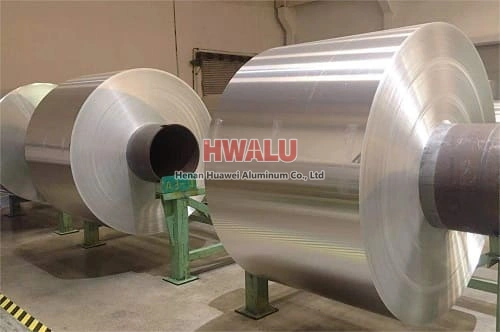What is a lidding foil? Lidding foil, also known as lid foil or lid, is a thin sheet of aluminum or composite material used to seal containers such as cups, jars, and trays to protect the contents inside. Lidding foils come in a variety of shapes, sizes, and designs to suit different types of containers and packaging applications. They can be printed with branding, logos, and product information to enhance a ...
What is 1050 H18 aluminum foil 1050 H18 aluminum foil is an aluminum foil material with high purity and good mechanical properties. Among them, 1050 represents the grade of aluminum alloy, and H18 represents the hardness level. 1050 aluminum alloy is an aluminum alloy with a purity of up to 99.5%, which has good corrosion resistance, thermal conductivity and machinability. H18 represents the aluminum foil aft ...
What is extra wide aluminum foil "Extra-wide aluminum foil" refers to aluminum foil that is wider than commonly used standard widths. Aluminum foil is a thin sheet of metal used for a variety of purposes, including packaging food, covering cooking dishes, and as a heat-resistant barrier. Extra wide aluminum foil thickness The standard width of household aluminum foil is usually about 12 inches (30 cm). Extra-w ...
What metal is 3003 Alloy Aluminum Foil? 3003 alloy aluminum foil is a medium-strength alloy with excellent atmospheric corrosion resistance, very good weldability, and good cold formability. Compared to 1000 series alloys, it has higher elongation and tensile strength, especially at elevated temperatures. The main states of aluminum foil 3003 include H 18, H22, H24, and other states upon request. It is ...
What is aluminum foil for wrapping Aluminum foil for wrapping is a thin, flexible sheet of aluminum that is commonly used for wrapping food items or other objects for storage or transportation. It is made from a sheet of aluminum that has been rolled out to a desired thickness and then processed through a series of rollers to give it the desired strength and flexibility. Aluminum foil for wrapping is availabl ...
What is thick aluminum foil Thick aluminum foil refers to a special type of aluminum foil that is thicker than regular aluminum foil. Usually, the thickness of the thick aluminum foil is between 0.2-0.3 mm, which is much thicker than regular aluminum foil. Like conventional aluminium foil, thick aluminum foil also has excellent properties, such as high electrical conductivity, fire prevention, corrosion resis ...
Aluminum foil factories will pay special attention to the following details when processing aluminum foil: Cleaning: Aluminum foil is very sensitive to impurities, any dust, oil or other contaminants will affect the quality and performance of the aluminum foil. Therefore, before processing aluminum foil, the production workshop, equipment and tools must be thoroughly cleaned to ensure that there is no contamin ...
Aluminum foil has good moisture-proof properties. Although pinholes will inevitably appear when the thickness of the aluminum foil is less than 0.025mm, when observed against light, the moisture-proof properties of aluminum foil with pinholes are much stronger than those of plastic films without pinholes. This is because the polymer chains of plastics are widely spaced apart from each other and cannot prevent wat ...
Packaging: food packaging, pharmaceutical packaging, cosmetic packaging, tobacco packaging, etc. This is because aluminum foil can effectively isolate light, oxygen, water, and bacteria, protecting the freshness and quality of products. Kitchen supplies: bakeware, oven trays, barbecue racks, etc. This is because the aluminum foil can effectively distribute the heat, making the food baked more evenly. In ...
Aluminum foil is a good packaging material, which can be used as food packaging, pharmaceutical packaging, and can also be used as a yogurt lid on yogurt. And aluminum foil is a common material choice for yogurt lids. The production process of aluminum foil for yogurt lid: Aluminum foil: Choose high-quality aluminum foil suitable for food packaging. It should be clean, free of any contaminants, and the cover sh ...
For the capsule shell, because it is made of aluminum, aluminum is an infinitely recyclable material. Capsule coffee generally uses an aluminum casing. Aluminum is the most protective material at present. It can not only lock the aroma of coffee, but also is light in weight and high in strength. At the same time, aluminum protects the coffee from foreign substances such as oxygen, moisture and light. For cof ...
It is generally believed that the single-sheet rolling speed of the aluminum foil should reach 80% of the rolling design speed of the rolling mill. Huawei Aluminum Company introduced a 1500 mm four-high irreversible aluminum foil roughing mill from Germany ACIIENACH. The design speed is 2 000 m/min. At present, the single-sheet aluminum foil rolling speed is basically at the level of 600m/miT, and the domestic si ...









